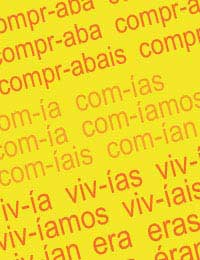The Past Imperfect Tense in Spanish

The past imperfect tense in Spanish is used to refer to an action in the past, of which the beginning or end is of no relevance to the context. In that sense, the action is incomplete, or ‘imperfect.’ It indicates that an event was in the process of happening in the past.
Formation of the Imperfect
To form the imperfect, take the infinitive of the verb and then remove the final two letters. In practice, this means –ar, -er, or –ir.
Then add the endings as follows. (Of course, the hypen is just to show you the stem and the endings: you wouldn’t normally write the words in the this way.)
For an –ar verb like comprar (to buy)
compr-aba
compr-abas
compr-aba
compr-ábamos
compr-abais
compr-aban
For an –er verb like comer (to eat)
com-ía
com-ías
com-ía
com-íamos
com-íais
com-ían
For an –ir verb like vivr (to live)
viv-ía
viv-ías
viv-ía
viv-íamos
viv-íais
viv-ían
Ser (To Be) and Ir (To Go) are Irregular in the Imperfect
Ser
era
eras
era
éramos
erais
eran
Ir
iba
ibas
iba
íbamos
ibaís
iban
Note that with the verb ‘ver’ (to see), the infinitive is so short that it only loses the ‘r’ from the infinitive, but keeps the ‘e’ in its stem. So you say ‘veía’ and so on.
Uses of the Imperfect
It is used to describe what was going on at the time it was being referred to.
En la capital, todavía reconstruían los barrios destruidos en el terremoto.
In the capital (city), they were still rebuilding the districts destroyed in the earthquake.
Also use this tense to give a descriptive background in the past.
Había mucha gente alrededor de la catedral, y aunque hacía calor, y brillaba el sol, una nube de humo colagaba sobre la ciudad.
There were a lot of people around the cathedral, and although it was hot, and the sun was shining, a cloud of smoke hunger over the city.
The imperfect tense is also a way of showing courtesy in requests and enquiries.
¿Qué deseaba?
What did you want/What would you like?
Quería hablar con el director.
I’d like a word with the manager.
Used to
The imperfect tense is often used to describe repeated or habitual actions in the past, often conveying the idea of used to. When being used in this way, it is often accompanied by adverbs or expressions of time which indicate repetition, such as ‘a menudo’ (often) or ‘a veces’ (sometimes.)
Here’s an example:
Cuando vivía en el Reino Unido, iba a menudo a Chile.
When I lived (used to live) in the UK, I often went (used to go) to Chile.
Soler
This is what is called a modal verb and is often used in the imperfect to describe what you used to do.
Cuando vivía en el Reino Unido, solía ir a Chile todos los años.
When I lived in the UK, I used to go to Chile every year.
Contrasted with the Preterite
Note that in English, our simple past tense (lived) does not distinguish between completed single actions and repeated actions or description. Not so in Spanish, where completed actions in the past take the preterite tense. (Explained elsewhere on this site.)
Note also the difference between a progressive background action in the imperfect, and single instances of events in the past, for which you use the preterite.
The Imperfect Instead of the Conditional
We have explained the conditional tense elsewhere. As we have said, the imperfect is sometimes used in Spanish instead of the conditional tense, especially in colloquial language. Here’s another example:
Si tuviera la oportunidad de ir a Chile, ¡claro que la tomaba!
If I had the chance to go to Chile, of course I’d take it!
- How to Learn Future Tense in Spanish
- Spanish Words to Watch Out For
- The Subjunctive in Spanish
- Irregular Verbs in Spanish
- The Conditional Tense in Spanish
- The Past Preterite Tense in Spanish
- Personal Pronouns in Spanish
- The Infinitive in Spanish
- Ser and Estar in Spanish
- The Present Tense in Spanish
- Por and para in Spanish
- Accents in Spanish
- Personal a in Spanish
- Adjectives in Spanish
- Gender of Nouns in Spanish


Re: Spanish Phrases for Hotels
Hi, I work in a hotel in the US. I'm trying to learn phrases in Spanish to speak to my Spanish speaking guests. Phrases…
Re: Spanish Numbers Days and Months
How do you say the twelfth month in Spanish. Not the month itself. Just that phrase
Re: Personal Pronouns in Spanish
How come vosotros isn't in the subject pronouns?
Re: The Influence of Spanish on English
I have found this website very useful and the present article has helped me a lot in understanding the influence of…
Re: The Past Preterite Tense in Spanish
magb123 - Your Question:You have a typo on 'ser'. The first person singular is 'fui' not 'fu'Our Respo
Re: The Past Preterite Tense in Spanish
you have a typo on 'ser'. The first person singular is 'fui' not 'fu'
Re: Spanish Numbers Days and Months
I´m spanish, i could give custom classes to anyone interested.
Re: The Past Preterite Tense in Spanish
Some typos on this otherwise excellent page: "Ponder" for poder and "fu" for fui. You need a proofreader.
Re: Colours in Spanish and How They Are Used
i really found this site very helpful as a college student! thanks